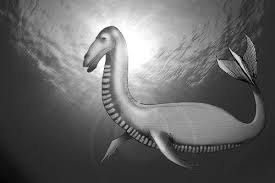Story
Tales of ‘Creature of Powell Lake’ persist
October 7, 2010 by admin
Monster or myth? Tales of ‘Creature of Powell Lake’ persist - Animal some say was otter or blacktip shark remains a mystery
The thing that tried to attack Eric Padgett nearly a half-century ago still pops up from time to time. While the corpse of the 40-pound “sea creature” was found a few months after it stalked Padgett, the story has never died. Padgett, 58, chuckled recently when asked if he ever had been written about in The News Herald.
“That old sea monster out there,” he said. As Halloween neared last week and monsters of all shapes and sizes prepared to poke out of the darkness, Padgett agreed to talk about the “Creature of Powell Lake” one more time. “I can remember it as plain as day,” Padgett said. “Just like yesterday.”
He was 11 when the encounter happened. It was August 1958, and Padgett was learning how to slalom ski in the water near Camp Helen State Park. Back then, Camp Helen was a recreational area for employees of the Avondale Textile Mills of Sylacauga, Ala. Padgett’s father, Howard, worked at the mill and was driving the boat on Lake Powell that day.
“He saw a head pop up in back of me,” Padgett said.
The monster appeared to be chasing him. Padgett said his father whirled the boat around to get between Padgett and the creature and snatched the boy out of the water with one hand. Although the creature had not hurt anyone, Padgett said his father felt sure Padgett was in danger.
“He said the head popped up, opened its mouth and was coming towards me,” Padgett said. “It could swim fairly fast.” Padgett did not get a glimpse of the sea creature until he was back in the boat.
“He was kind of a greasy black,” Padgett recalled.
His father and other boaters chased the creature around Lake Powell that day but could not catch it, Padgett said.
Then in February 1959, the carcass of a 4-foot long, 40-pound monster was discovered in “three feet of brackish water in Lattimer’s Bayou near Phillip’s inlet,” The News Herald reported. Writer David Chandler described the critter this way: It “had nostrils, ribs, and lungs, rounded flippers, a dorsal fin and an oversize jaw with three rows of teeth comparable in size and structure to a shark’s.”
No one could identify the strange creature, so the head was removed and sent to The Smithsonian Institution in Washington, D.C.
Contacted this month, an official with the Smithsonian said it would be nearly impossible to find out what happened to the specimen without knowing who had received the head almost 50 years ago. The official also giggled — frequently.
Luckily, The News Herald reported the Smithsonian’s findings more than once. Scientists said it was a blacktip shark, common to the area because the Gulf of Mexico flowed into Lake Powell at that time. But Padgett maintains that finding is as murky as a Florida pond.
“It had lungs. It was a mammal.” Padgett said. “It looked exactly like the picture.”
The picture to which he referred is a sketch of a Loch Ness Monster-esque critter printed with the original newspaper story on the discovery of the creature’s remains. Some believe that News Herald cartoonist Wally Reichert stressed visual energy over geographic or biological accuracy.
Mike Brim, St. Andrew Bay Environmental Study Team executive director, shook his head as he looked at the sketch recently.
“It’s got a very nice dorsal fin of a shark, the head of a brontosaurus, the front fins of a manatee and the tail of an alligator,” Brim said.
Padgett believes the beast that went after him was an otter. Otters used to come to Camp Helen and bark at picnickers, he said.
“I think it was one of those otters that got hit by a boat and that kind of deformed the back end of it,” Padgett said.
Padgett never saw the carcass, but he always has believed that the thing that washed ashore that day was the same creature that chased him.
Brim has faith in the Smithsonian.
“I have great confidence in the ability of the Smithsonian to tell a blacktip shark when they’re given one,” he said.
However, Brim did say the eyewitness accounts disagree with the findings.
“If Padgett said that the thing popped its head out of the water, that’s consistent with river otter,” Brim said. “A blacktip shark wouldn’t pop out of the water.”Brim suggested that since Padgett never saw the carcass of the creature, it is possible that there were two distinct animals at play in Lake Powell that year.
Brim discounted the possibility that the creature was an entirely new species. Earth’s oceans still hold some secrets but only in the few leagues where man has not ventured, he said.
“I’m sure there are (new) species in the abysmal depths of the ocean,” Brim said. But “only probably in the deepest parts of the ocean.”
Padgett was famous at school after the incident, but fame was fleeting, he said.
“When school started, one of the kids came up to me and wanted my autograph. That was the only time anyone has ever wanted my autograph,” Padgett said. “Except my wife to sign checks.”
After the initial brush with fame, Padgett’s life went back to normal. He joined the U.S. Air Force, then worked for the Panama City Beach Police Department until, finally, taking a job at Camp Helen State Park as assistant manager. The park maintains a small exhibit dedicated to the creature.
Padgett is now retired for health reasons.
Even after a monster from the deep tried to attack him, Padgett said he continued to play in the water. He eventually learned how to slalom and still returns to the lake when he is able.
“I go fishing out there sometimes,” he said.
Originall published Monday, October 31, 2005 in News Herald

















